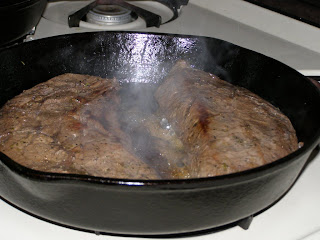Cast Iron Skillet Cornbread is to some the holy grail of cast iron skillet cooking. Perfect golden brown cornbread perfection is so hard to achieve if you don’t know a few secrets to success. Then there’s the whole white cornmeal or yellow cornmeal, North vs. South issue to deal with. The North vs. South issue continues with sugar or no sugar, flour or no flour or some flour. I tried a Texas recipe with just yellow cornmeal and no flour and it came out like a flat dense Johnnycake. I’m sure some people love it that way but it wasn’t to my taste. Well I’m not here to fuel fire to those debates as I just want to share some secrets that will make your cast iron skillet cornbread cooking experience memorable one. Memorable as in perfect golden brown moist cornbread perfection, not memorable as in “My freakin’ cornbread burned and stuck to the skillet and I hate this heavy cast iron piece of bleep!”. I have also seen a lot of recipes calling for butter in the skillet. I haven’t had much success with just butter as the butter solids tend to burn at these high temperatures. Most recipes I’ve read had said to invert the cornbread onto a plate yet it is rare to see a picture of one this way, so I’m going to show you my bottom. Err, I mean I’m going to show you my cornbread inverted.

Here are the tips to success. Obviously you will want to use a well seasoned skillet. Use three bowls for preparation. One for wet ingredients, one for dry ingredients and one working bowl for measuring the dry ingredients. Your measuring cups for dry ingredients should be flat on top. Measuring cups with curved tops and spouts are for liquids. When measuring use the scoop and level method. Scoop the dry measure cup into the cornmeal / flour then hold over the working bowl and level the top with a straight edge. Next sift the flour, baking powder, baking soda and salt into the cornmeal and mix thoroughly. Lightly mix the egg into the buttermilk. Don’t whisk it to frothy foam as there is no need to incorporate that much air into the egg white. Now here’s an important part. Pour the dry ingredients into the buttermilk egg mixture and stir slowly with a large spoon until just combined. Don’t overwork the cornbread! Now add any other flavor ingredients you want and stir gently until incorporated. While all this is going on you should have been pre-heating your oven to 425F unless you have one of those three minute super ovens. Place the skillet with about four tablespoons of oil into the pre-heated oven for about 10 minutes.You can also use clarified butter or three tablespoons oil and a tablespoon of butter. When you remove the hot skillet from the oven pour two tablespoons of the hot oil into the cornbread batter. It will sizzle when it hits the top of the batter, then stir to incorporate the oil. Cook for twenty minutes then remove and let stand for ten minutes. During this standing time, take a knife and run it around the edge of the skillet to loosen the cornbread to make inverting it onto the plate easier.

Skillet Cornbread Recipe Ingredients
• 1 1/4 cups stone-ground yellow cornmeal
• 1 cup of all purpose flour
• 2 teaspoons baking powder
• 1 teaspoon baking soda
• ½ teaspoon salt
• 1 ½ cups buttermilk
• 1 large egg
• Additional flavor ingredients. I used bacon, jalapeño and onion.
Here's one where I used oil and butter. Notice the browned butter solids around the edge. The top looked better on this one. This is the method I usually use.

Time to eat!
































